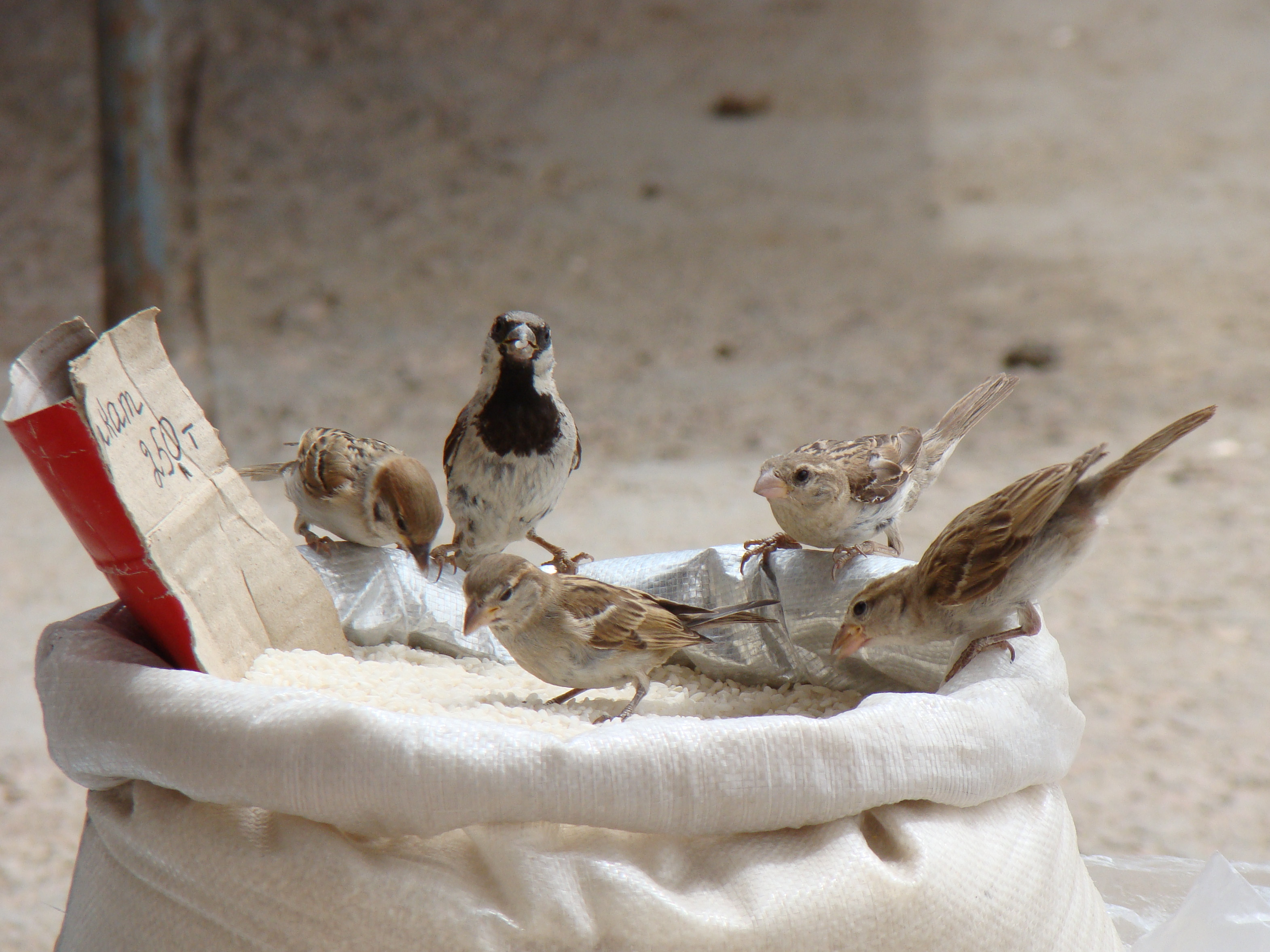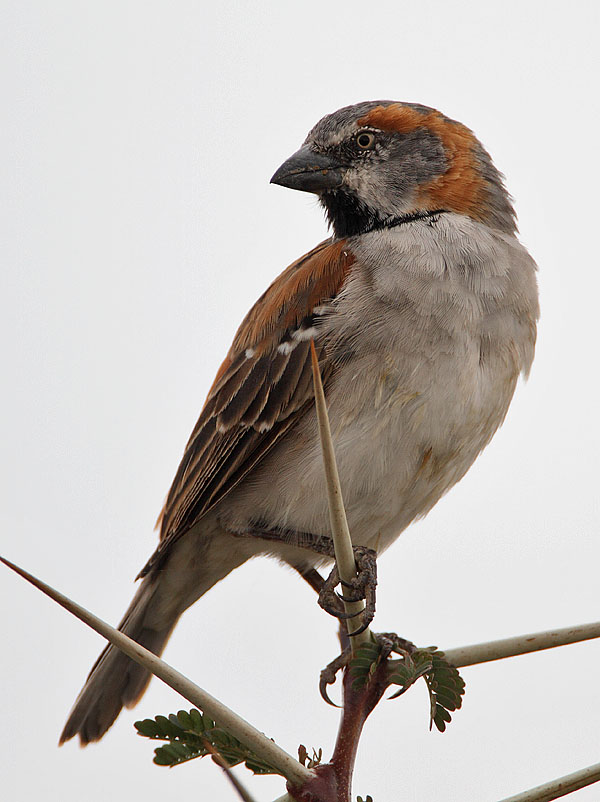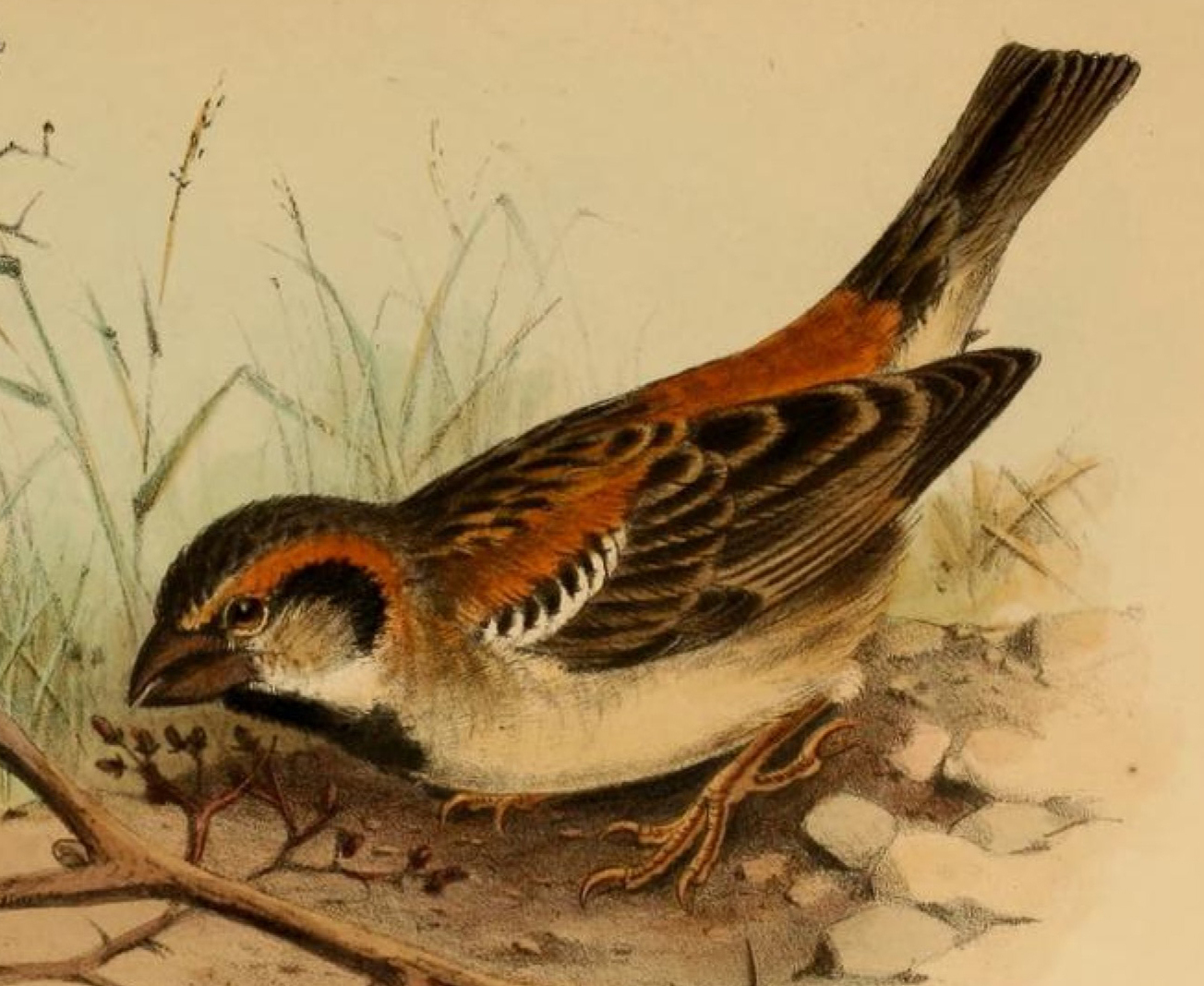|
Passer
''Passer'' is a genus of sparrows, also known as the true sparrows. The genus contains 28 species and includes the house sparrow and the Eurasian tree sparrow, two of the most common birds in the world. They are small birds with thick bills for eating seeds, and are mostly coloured grey or brown. Native to the Old World, some species have been introduced throughout the world. Taxonomy The genus ''Passer'' was introduced by the French zoologist Mathurin Jacques Brisson in 1760. The type species was subsequently designated as the house sparrow (''Passer domesticus''). The name ''Passer'' is the Latin word for "sparrow." Studies by Arnaiz-Villena et al. have examined the evolutionary relationships of the genus ''Passer'' with other members of the family Passeridae, and of members of the genus in relation to each other. According to a study by Arnaiz Villena et al. published in 2001, the genus originated in Africa and the Cape sparrow is the most basal lineage. The particular l ... [...More Info...] [...Related Items...] OR: [Wikipedia] [Google] [Baidu] |
Eurasian Tree Sparrow
The Eurasian tree sparrow (''Passer montanus'') is a passerine bird in the sparrow family with a rich chestnut crown and nape, and a black patch on each pure white cheek. The sexes are similarly plumaged, and young birds are a duller version of the adult. This sparrow breeds over most of temperate Eurasia and Southeast Asia, where it is known as the tree sparrow, and it has been introduced elsewhere including the United States, where it is known as the Eurasian tree sparrow or German sparrow to differentiate it from the native unrelated American tree sparrow. Although several subspecies are recognised, the appearance of this bird varies little across its extensive range. The Eurasian tree sparrow's untidy nest is built in a natural cavity, a hole in a building or the disused nest of a European magpie or white stork. The typical clutch is five or six eggs which hatch in under two weeks. This sparrow feeds mainly on seeds, but invertebrates are also consumed, particularly du ... [...More Info...] [...Related Items...] OR: [Wikipedia] [Google] [Baidu] |
House Sparrow
The house sparrow (''Passer domesticus'') is a bird of the sparrow family Passeridae, found in most parts of the world. It is a small bird that has a typical length of and a mass of . Females and young birds are coloured pale brown and grey, and males have brighter black, white, and brown markings. One of about 25 species in the genus ''Passer'', the house sparrow is native to most of Europe, the Mediterranean Basin, and a large part of Asia. Its intentional or accidental introductions to many regions, including parts of Australasia, Africa, and the Americas, make it the most widely distributed wild bird. The house sparrow is strongly associated with human habitation, and can live in urban or rural settings. Though found in widely varied habitats and climates, it typically avoids extensive woodlands, grasslands, and deserts away from human development. It feeds mostly on the seeds of grains and weeds, but it is an opportunistic eater and commonly eats insects and many o ... [...More Info...] [...Related Items...] OR: [Wikipedia] [Google] [Baidu] |
House Sparrow
The house sparrow (''Passer domesticus'') is a bird of the sparrow family Passeridae, found in most parts of the world. It is a small bird that has a typical length of and a mass of . Females and young birds are coloured pale brown and grey, and males have brighter black, white, and brown markings. One of about 25 species in the genus ''Passer'', the house sparrow is native to most of Europe, the Mediterranean Basin, and a large part of Asia. Its intentional or accidental introductions to many regions, including parts of Australasia, Africa, and the Americas, make it the most widely distributed wild bird. The house sparrow is strongly associated with human habitation, and can live in urban or rural settings. Though found in widely varied habitats and climates, it typically avoids extensive woodlands, grasslands, and deserts away from human development. It feeds mostly on the seeds of grains and weeds, but it is an opportunistic eater and commonly eats insects and many o ... [...More Info...] [...Related Items...] OR: [Wikipedia] [Google] [Baidu] |
Passer Rufocinctus -Ol Pejeta Conservancy, Kenya-8
''Passer'' is a genus of sparrows, also known as the true sparrows. The genus contains 28 species and includes the house sparrow and the Eurasian tree sparrow, two of the most common birds in the world. They are small birds with thick bills for eating seeds, and are mostly coloured grey or brown. Native to the Old World, some species have been introduced throughout the world. Taxonomy The genus ''Passer'' was introduced by the French zoologist Mathurin Jacques Brisson in 1760. The type species was subsequently designated as the house sparrow (''Passer domesticus''). The name ''Passer'' is the Latin word for "sparrow." Studies by Arnaiz-Villena et al. have examined the evolutionary relationships of the genus ''Passer'' with other members of the family Passeridae, and of members of the genus in relation to each other. According to a study by Arnaiz Villena et al. published in 2001, the genus originated in Africa and the Cape sparrow is the most basal lineage. The particula ... [...More Info...] [...Related Items...] OR: [Wikipedia] [Google] [Baidu] |
Passer Montanus Baikonur 001
''Passer'' is a genus of sparrows, also known as the true sparrows. The genus contains 28 species and includes the house sparrow and the Eurasian tree sparrow, two of the most common birds in the world. They are small birds with thick bills for eating seeds, and are mostly coloured grey or brown. Native to the Old World, some species have been introduced throughout the world. Taxonomy The genus ''Passer'' was introduced by the French zoologist Mathurin Jacques Brisson in 1760. The type species was subsequently designated as the house sparrow (''Passer domesticus''). The name ''Passer'' is the Latin word for "sparrow." Studies by Arnaiz-Villena et al. have examined the evolutionary relationships of the genus ''Passer'' with other members of the family Passeridae, and of members of the genus in relation to each other. According to a study by Arnaiz Villena et al. published in 2001, the genus originated in Africa and the Cape sparrow is the most basal lineage. The particula ... [...More Info...] [...Related Items...] OR: [Wikipedia] [Google] [Baidu] |
Old World Sparrow
Old World sparrows are a group of small passerine birds forming the family Passeridae. They are also known as true sparrows, a name also used for a particular genus of the family, ''Passer''. They are distinct from both the New World sparrows, in the family Passerellidae, and from a few other birds sharing their name, such as the Java sparrow of the family Estrildidae. Many species nest on buildings and the house and Eurasian tree sparrows, in particular, inhabit cities in large numbers. They are primarily seed-eaters, though they also consume small insects. Some species scavenge for food around cities and, like gulls or pigeons, will eat small quantities of a diversity of items. Description Generally, Old World sparrows are small, plump, brown and grey birds with short tails and stubby, powerful beaks. The differences between sparrow species can be subtle. Members of this family range in size from the chestnut sparrow (''Passer eminibey''), at and , to the parrot-billed spa ... [...More Info...] [...Related Items...] OR: [Wikipedia] [Google] [Baidu] |
Cape Sparrow
The Cape sparrow (''Passer melanurus''), or mossie, is a bird of the sparrow family Passeridae found in southern Africa. A medium-sized sparrow at , it has distinctive plumage, including large pale head stripes in both sexes. Its plumage is mostly grey, brown, and chestnut, and the male has some bold black and white markings on its head and neck. The species inhabits semi-arid savannah, cultivated areas, and towns, and ranges from the central coast of Angola to eastern South Africa and Eswatini. Three subspecies are distinguished in different parts of its range. Cape sparrows primarily eat seeds, and also eat soft plant parts and insects. They typically breed in colonies, and when not breeding they gather in large nomadic flocks to move around in search of food. The nest can be constructed in a tree, a bush, a cavity, or a disused nest of another species. A typical clutch contains three or four eggs, and both parents are involved in breeding, from nest building to feeding youn ... [...More Info...] [...Related Items...] OR: [Wikipedia] [Google] [Baidu] |
Chestnut Sparrow
The chestnut sparrow (''Passer eminibey'') is a species of passerine bird in the sparrow family Passeridae. It is the smallest member of the sparrow family, at about long. The breeding male has deep chestnut plumage and the female and juvenile are coloured a duller grey with some chestnut markings. Like its closest relatives in the genus ''Passer'', the Arabian golden sparrow and the Sudan golden sparrow, it is gregarious and found in arid areas. Ranging through the east of Africa from Darfur in Sudan to Tanzania, it is found in dry savanna, papyrus swamps, and near human habitation. Adults and juveniles both feed mostly on grass seeds, and fly in flocks, often with other species of birds, to find food. It nests in trees, building its own domed nests, and also usurping the more elaborate nests of weavers. Taxonomy and systematics This species was first described in 1880, by Gustav Hartlaub in the ''Journal für Ornithologie'', as ''Sorella Emini Bey''. Hartlaub gave it the sp ... [...More Info...] [...Related Items...] OR: [Wikipedia] [Google] [Baidu] |
Northern Grey-headed Sparrow
The northern grey-headed sparrow (''Passer griseus''), also known as the grey-headed sparrow, is a species of bird in the sparrow family Passeridae, which is resident in much of tropical Africa. It occurs in a wide range of open habitats, including open woodlands and human habitation, often occupying the same niche as the house sparrow does in Eurasia. The adult northern grey-headed sparrow has a pale grey head with a white moustache stripe, pale brown upperparts, whitish underparts and chestnut wings with a small white shoulder patch. The sexes are similar, but young birds are slightly duller and lack the white wing patch. There are three subspecies, differing in plumage tone, especially with regard to the darkness of the head. This sparrow is mainly resident in its range, but there is some seasonal movement, and flocks of up to 50 birds form outside the breeding season. It builds a cup nest in trees, thatch, or old nests of other birds; 2–4 eggs are laid. This species fee ... [...More Info...] [...Related Items...] OR: [Wikipedia] [Google] [Baidu] |
Northern Grey-headed Sparrow (Passer Griseus Ugandae)
The northern grey-headed sparrow (''Passer griseus''), also known as the grey-headed sparrow, is a species of bird in the sparrow family Passeridae, which is resident in much of tropical Africa. It occurs in a wide range of open habitats, including open woodlands and human habitation, often occupying the same niche as the house sparrow does in Eurasia. The adult northern grey-headed sparrow has a pale grey head with a white moustache stripe, pale brown upperparts, whitish underparts and chestnut wings with a small white shoulder patch. The sexes are similar, but young birds are slightly duller and lack the white wing patch. There are three subspecies, differing in plumage tone, especially with regard to the darkness of the head. This sparrow is mainly resident in its range, but there is some seasonal movement, and flocks of up to 50 birds form outside the breeding season. It builds a cup nest in trees, thatch, or old nests of other birds; 2–4 eggs are laid. This species fee ... [...More Info...] [...Related Items...] OR: [Wikipedia] [Google] [Baidu] |
Shelley's Sparrow
Shelley's sparrow (''Passer shelleyi''), also known as Shelley's rufous sparrow or the White Nile rufous sparrow, is a sparrow found in eastern Africa from South Sudan, southern Ethiopia, and north-western Somalia to northern Uganda and north-western Kenya. Formerly, it was considered as a subspecies of the Kenya sparrow. This species is named after English geologist A geologist is a scientist who studies the solid, liquid, and gaseous matter that constitutes Earth and other terrestrial planets, as well as the processes that shape them. Geologists usually study geology, earth science, or geophysics, althoug ... and ornithologist George Ernest Shelley. References Works cited * External links White Nile rufous sparrowat the Internet Bird Collection Passer Birds of East Africa Birds described in 1891 {{passeridae-stub ... [...More Info...] [...Related Items...] OR: [Wikipedia] [Google] [Baidu] |
Kordofan Sparrow
The Kordofan sparrow (''Passer cordofanicus''), also known as the Kordofan rufous sparrow, is a sparrow found only in southwestern Sudan and adjacent border regions of South Sudan and Chad. It is frequently considered a subspecies of the Kenya sparrow, which in turn is considered a subspecies of the great sparrow. References ;Further reading * * Passer Birds of North Africa Birds described in 1874 Taxa named by Theodor von Heuglin {{Passeridae-stub ... [...More Info...] [...Related Items...] OR: [Wikipedia] [Google] [Baidu] |


_immature_Udaipur.jpg)

%2C_Passer_motitensis_at_Marakele_National_Park%2C_South_Africa_(7796691488).jpg)
.jpg)

